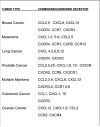The good and the bad of chemokines/chemokine receptors in melanoma
- PMID: 19222802
- PMCID: PMC2848967
- DOI: 10.1111/j.1755-148X.2009.00554.x
The good and the bad of chemokines/chemokine receptors in melanoma
Abstract
Chemokine ligand/receptor interactions affect melanoma cell growth, stimulate or inhibit angiogenesis, recruit leukocytes, promote metastasis, and alter the gene expression profile of the melanoma associated fibroblasts. Chemokine/chemokine receptor interactions can protect against tumor development/growth or can stimulate melanoma tumor progression, tumor growth and metastasis. Metastatic melanoma cells express chemokine receptors that play a major role in the specifying the organ site for metastasis, based upon receptor detection of the chemokine gradient elaborated by a specific organ/tissue. A therapeutic approach that utilizes the protective benefit of chemokines involves delivery of angiostatic chemokines or chemokines that stimulate the infiltration of cytotoxic T cells and natural killer T cells into the tumor microenvironment. An alternative approach that tackles the tumorigenic property of chemokines uses chemokine antibodies or chemokine receptor antagonists to target the growth and metastatic properties of these interactions. Based upon our current understanding of the role of chemokine-mediated inflammation in cancer, it is important that we learn to appropriately regulate the chemokine contribution to the tumorigenic 'cytokine/chemokine storm', and to metastasis.
Figures



Similar articles
-
Role of chemokines in tumor growth.Cancer Lett. 2007 Oct 28;256(2):137-65. doi: 10.1016/j.canlet.2007.05.013. Epub 2007 Jul 12. Cancer Lett. 2007. PMID: 17629396 Free PMC article. Review.
-
Targeting Chemokines and Chemokine Receptors in Melanoma and Other Cancers.Front Immunol. 2018 Oct 29;9:2480. doi: 10.3389/fimmu.2018.02480. eCollection 2018. Front Immunol. 2018. PMID: 30420855 Free PMC article. Review.
-
The angiostatic activity of interferon-inducible protein-10/CXCL10 in human melanoma depends on binding to CXCR3 but not to glycosaminoglycan.Mol Ther. 2004 Jun;9(6):846-55. doi: 10.1016/j.ymthe.2004.01.010. Mol Ther. 2004. PMID: 15194051 Free PMC article.
-
Chemokines and Chemokine Receptors: Orchestrating Tumor Metastasization.Int J Mol Sci. 2018 Dec 27;20(1):96. doi: 10.3390/ijms20010096. Int J Mol Sci. 2018. PMID: 30591657 Free PMC article. Review.
-
Chemokines, chemokine receptors, and cancer metastasis.J Leukoc Biol. 2006 Apr;79(4):639-51. doi: 10.1189/jlb.1105633. Epub 2006 Feb 14. J Leukoc Biol. 2006. PMID: 16478915 Review.
Cited by
-
IRF-8 controls melanoma progression by regulating the cross talk between cancer and immune cells within the tumor microenvironment.Neoplasia. 2012 Dec;14(12):1223-35. doi: 10.1593/neo.121444. Neoplasia. 2012. PMID: 23308054 Free PMC article.
-
Contribution of Keratinocytes in Skin Cancer Initiation and Progression.Int J Mol Sci. 2024 Aug 13;25(16):8813. doi: 10.3390/ijms25168813. Int J Mol Sci. 2024. PMID: 39201498 Free PMC article. Review.
-
Vascular dysfunction and increased metastasis of B16F10 melanomas in Shb deficient mice as compared with their wild type counterparts.BMC Cancer. 2015 Apr 8;15:234. doi: 10.1186/s12885-015-1269-y. BMC Cancer. 2015. PMID: 25885274 Free PMC article.
-
CCR9:CCL25 in melanoma metastatic to small intestine.Curr Oncol Rep. 2009 Sep;11(5):331-2. doi: 10.1007/s11912-009-0056-9. Curr Oncol Rep. 2009. PMID: 19679006 No abstract available.
-
Molecular profiling of primary uveal melanomas with tumor-infiltrating lymphocytes.Oncoimmunology. 2014 Oct 31;8(10):e947169. doi: 10.4161/21624011.2014.947169. eCollection 2019. Oncoimmunology. 2014. PMID: 31646061 Free PMC article.
References
-
- Balentien E, Mufson BE, Shattuck RL, Derynck R, Richmond A. Effects of MGSA/GRO alpha on melanocyte transformation. Oncogene. 1991;6:1115–1124. - PubMed
-
- Balkwill F, Charles KA, Mantovani A. Smoldering and polarized inflammation in the initiation and promotion of malignant disease. Cancer Cell. 2005;7:211–217. - PubMed
-
- Balkwill F, Mantovani A. Inflammation and cancer: back to Virchow? Lancet. 2001;357:539–545. - PubMed
Publication types
MeSH terms
Substances
Grants and funding
LinkOut - more resources
Full Text Sources
Medical
Research Materials

